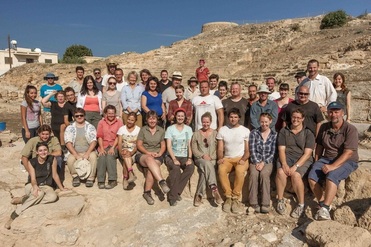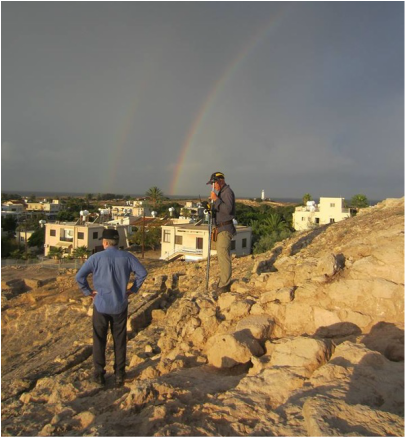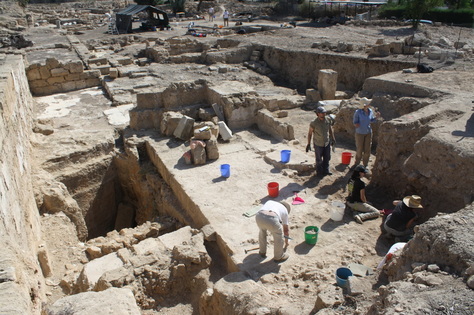Nea Paphos Theatre Excavations 2012 |
by Dr Craig Barker.
First published: The AAIA Bulletin , Vol. 10, 2014, 10-11. |
|
Archaeological excavations at the ancient theatre of Nea Paphos were continued in 2012 by a team from the University of Sydney (fig. 1) who unearthed a number of significant finds, including fragments of marble sculptural adornments from the theatre's stage building and a nearby nymphaeum.
The season (24 September-26 October 2012) was the fifteenth season of archaeological investigations of the precinct of the Hellenistic-Roman theatre of Nea Paphos on behalf of the Department of Antiquities of Cyprus. The team of 34 archaeologists and students worked on the southern slope of Fabrika hill, under the direction of Dr Craig Barker and Dr Smadar Gabrieli. The Australian archaeological excavations in Paphos are supported by the Nicholson Museum and the Australian Archaeological Institute at Athens. Nea Paphos served as the capital of Cyprus in the Hellenistic and Roman periods and the archaeological remains of the important trading settlement, including the theatre, are inscribed on the World Heritage List. In keeping with the status of Paphos in the Hellenistic and Roman periods, the theatre has proved to be one ofthe largest in Cyprus. Investigations have revealed that the theatre of Paphos underwent five phases of renovations between 300 BC and the 4th century AD, each phase representing the evolution of ancient performance and theatre architecture. Many of the architectural features were robbed away in antiquity, and the area of the site was built over in the Middle Ages. The theatre of Paphos is the only ancient theatre of Cyprus not to have undergone modem restoration, and as such is now a unique structure on the island as it is the sole remaining theatre containing visible traces of its architectural development. The study of the theatre has given great insight into the spread of Hellenic cultural identity in the eastern Mediterranean and also of the changes to theatrical architecture over the six and a half centuries the structure was in use, which included phases of Ptolemaic and Roman influence. Five trenches were opened by the team in 2012 in various locations around the theatre as well as in the nearby Roman nymphaeum and road that have been reported on in previous volumes of the AAIABulletin. The main trench, Trench 12A, was on the eastern side of the stage building, and located the bedrock foundations of the eastern end of the Roman stage. This was a significant area of excavation, providing new insight into the dimensions of the earlier phases of the stage building. This trench also identified a new entrance way leading from the south onto the eastern parodos of the theatre. This stone entrance-way was located at a lower level than the previously-known Roman one which provides some clues as to the architectural layout of the Hellenistic theatre. Trench 12B continued work in the area of the Roman road directly to the south of the theatre that began in 2010, clearing more of the road pavements and more of a medieval building located above it. The road is proving to be an important feature in our understanding of the urban layout of the ancient city, and will be further excavated in coming seasons. Trench 12C on the other hand was located on the upper levels of the cavea (seating) and indicates that there were significant buildings with sizable walls constructed on the top of Fabrika hill after the theatre was no longer in use for performance. Trench 12D was located in the area of the western parodos of the theatre (fig. 3), while Trench 12E explored a post-medieval well located to the south east of the site. In parallel with the excavation, the team's specialists continued archaeological interpretation of the architecture and finds from the site for final academic publication in the near future. A number of senior team members also participated in a major international conference on the archaeology of Paphos held at the University of Avignon immediately after the excavation. |
|


